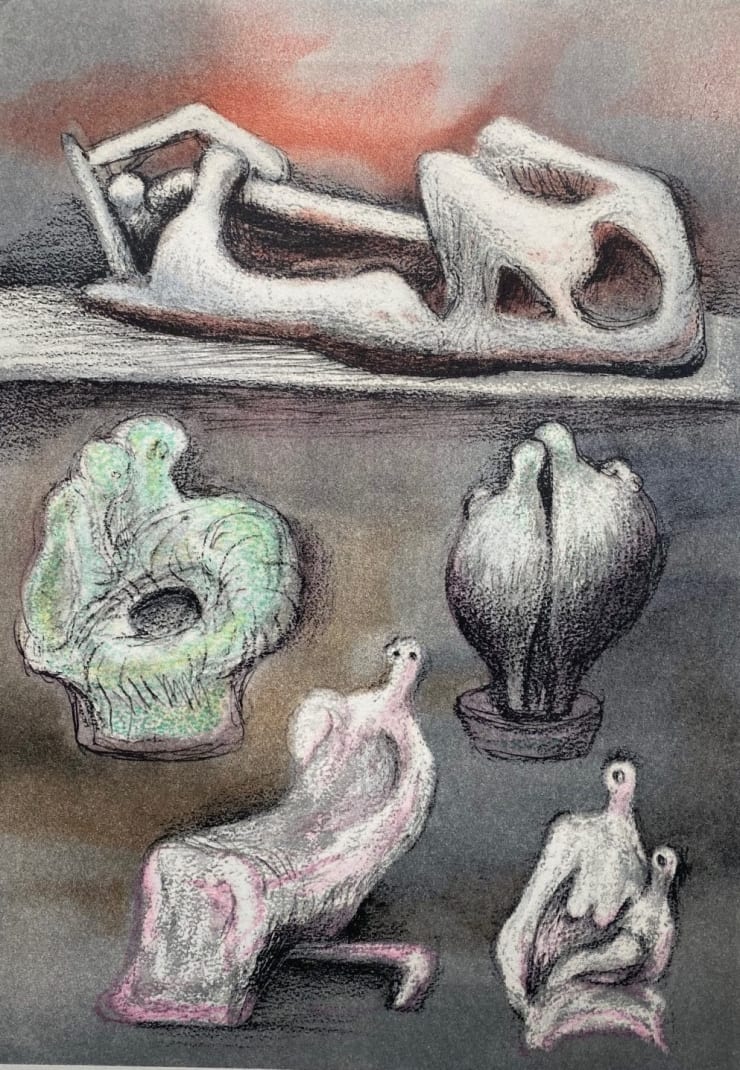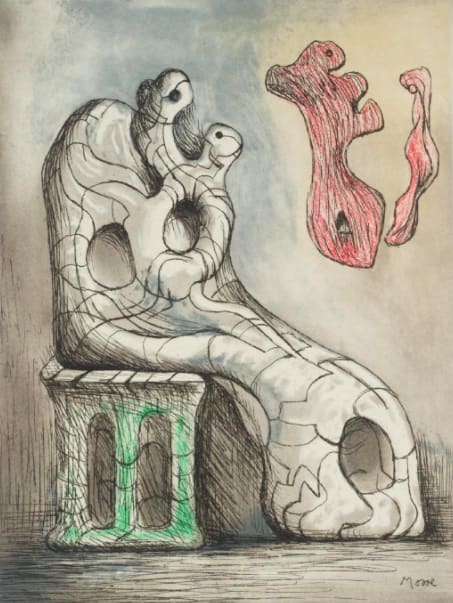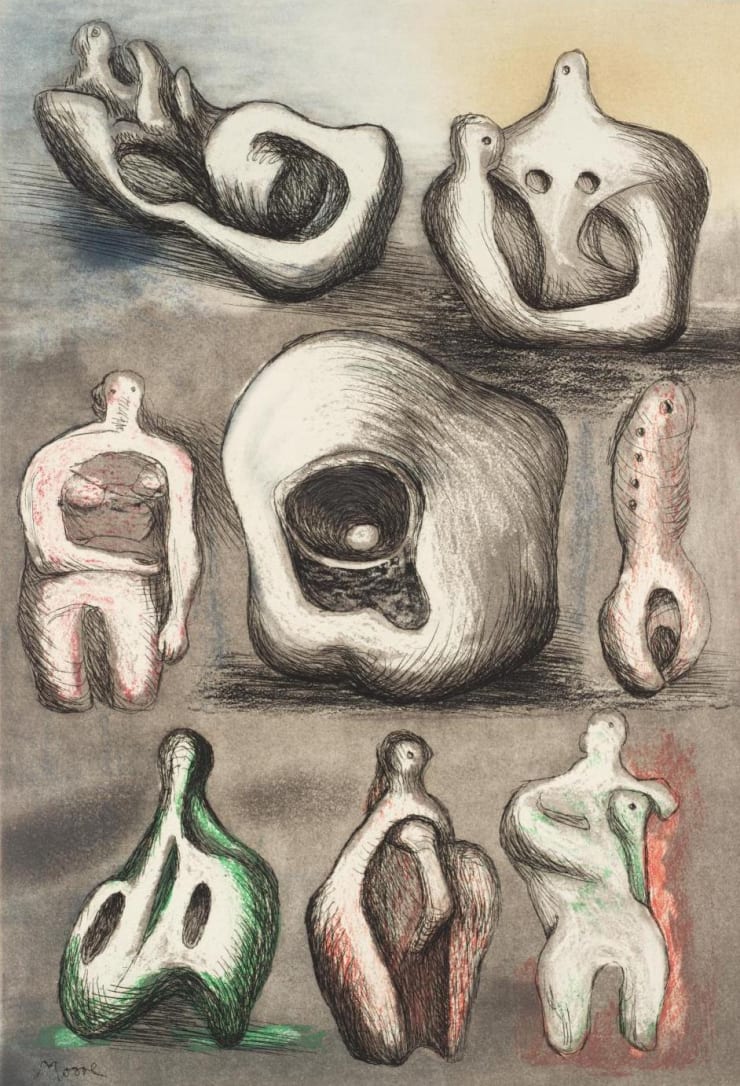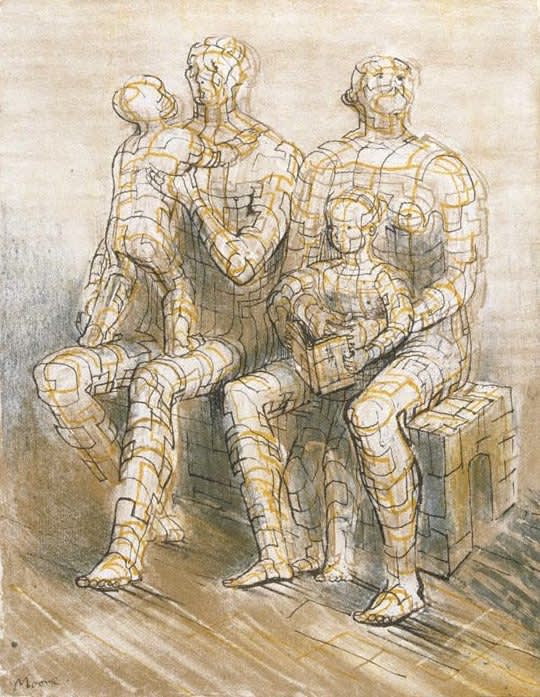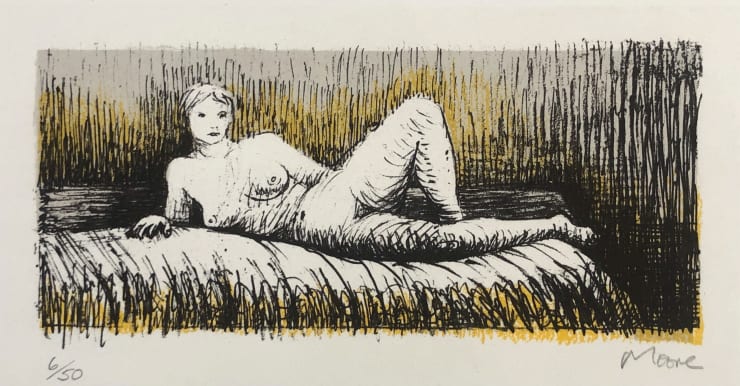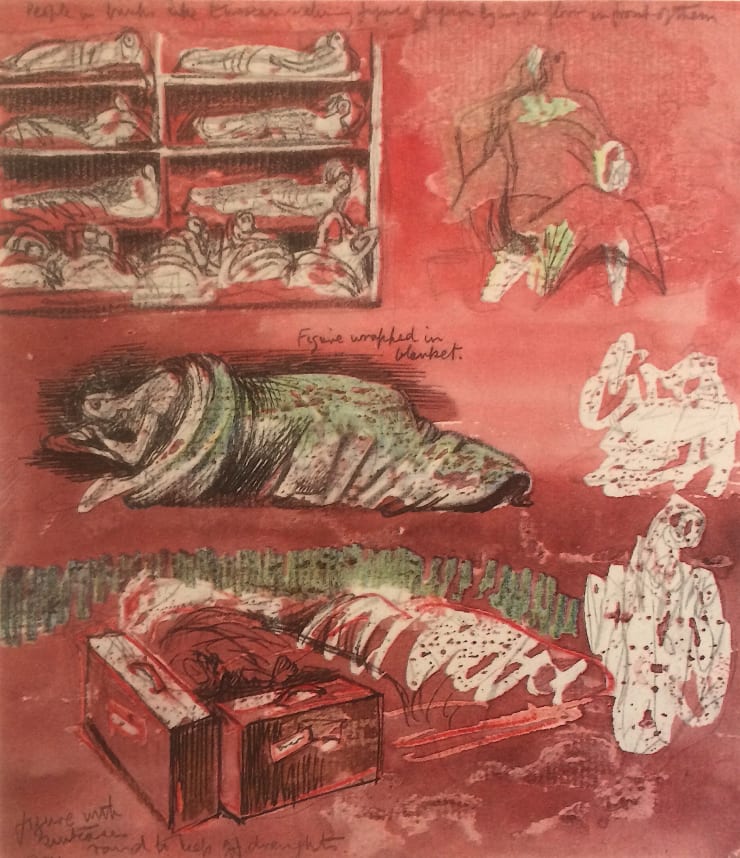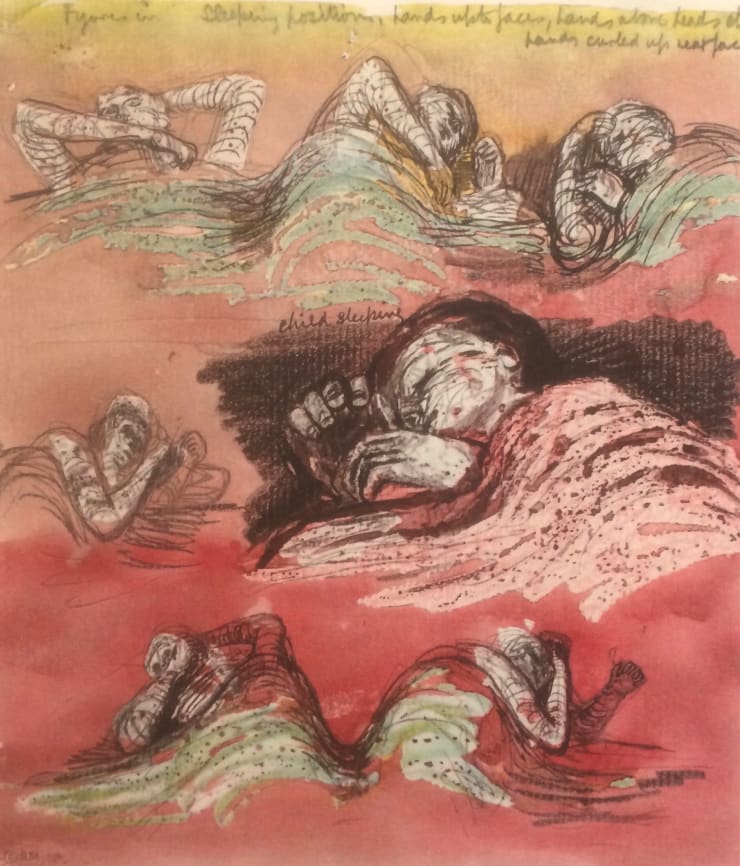Works on paper: 1950 - 1980
26 May - 26 June, 2022
Eames Fine Art Gallery is delighted to present an exhibition of works on paper by Henry Moore from the artist's post-war period through to his later years.
Comprising original lithographs, etchings and collotypes the exhibition brings together works from Moore's seminal Shelter Sketchbook series and Prometheus illustrations, alongside reclining nudes and mother and child studies.
-
“The secret of life is to have a task, something you devote your entire life to, something you bring everything to, every minute of the day for the rest of your life. And the most important thing is, it must be something you cannot possibly do.”
- Henry Moore
-

Prométhée, 1950, Lithograph.
-
Prometheus Illustrations
-
 Henry MooreProméthée, 1950£500.00
Henry MooreProméthée, 1950£500.00 -
 Henry MooreHead of Prometheus, 1950Sold
Henry MooreHead of Prometheus, 1950Sold -
 Henry MooreMinerva, Prometheus and Pandora, 1950Sold
Henry MooreMinerva, Prometheus and Pandora, 1950Sold -
 Henry MoorePrometheus on the Rock, 1950Sold
Henry MoorePrometheus on the Rock, 1950Sold -
 Henry MooreThe Four Sketches, 1950Sold
Henry MooreThe Four Sketches, 1950Sold -
 Henry MooreTwilight Landscape, 1950
Henry MooreTwilight Landscape, 1950 -
 Henry MooreDeath of Mira, 1950Sold
Henry MooreDeath of Mira, 1950Sold -
 Henry MoorePandora and the Imprisoned Statues, 1950Sold
Henry MoorePandora and the Imprisoned Statues, 1950Sold -
 Henry MooreTrees, 1950Sold
Henry MooreTrees, 1950Sold
-
-
"The violent quarrel between the abstractionists and the surrealists seems to me quite unnecessary. All good art has contained both abstract and surrealist elements, just as it has contained both classical and romantic elements – order and surprise, intellect and imagination, conscious and unconscious. Both sides of the artist's personality must play their part."
- Henry Moore, Listener, 18 August 1937
-
Reclining Nudes | Mother & Child | Figurative Works
-
 Henry MooreReclining Mother and Child with Blue Background, 1982£8,900.00
Henry MooreReclining Mother and Child with Blue Background, 1982£8,900.00 -
 Henry MooreSeated Figure Back, 1974Sold
Henry MooreSeated Figure Back, 1974Sold -
 Henry MooreReclining Figure, 1976Sold
Henry MooreReclining Figure, 1976Sold -
 Henry MooreSculptural Ideas 4, 1980Sold
Henry MooreSculptural Ideas 4, 1980Sold -
 Henry MooreSculptural Ideas 3, 1980Sold
Henry MooreSculptural Ideas 3, 1980Sold -
 Henry MooreFive Ideas for Sculpture, 1981Sold
Henry MooreFive Ideas for Sculpture, 1981Sold -
 Henry MooreSeven Sculpture Ideas II, 1980 - 1981£3,950.00
Henry MooreSeven Sculpture Ideas II, 1980 - 1981£3,950.00 -
 Henry MooreSeated Mother and Child, 1980/81£3,950.00
Henry MooreSeated Mother and Child, 1980/81£3,950.00 -
 Henry MooreEight Sculpture Ideas, 1980£3,950.00
Henry MooreEight Sculpture Ideas, 1980£3,950.00 -
 Henry MooreTwo Seated Women, 1967£3,500.00
Henry MooreTwo Seated Women, 1967£3,500.00 -
 Henry MooreThree Standing Figures (Shelter Sketchbook) , 1966Sold
Henry MooreThree Standing Figures (Shelter Sketchbook) , 1966Sold -
 Henry MooreViolet Torso on Orange Stripes, 1967Sold
Henry MooreViolet Torso on Orange Stripes, 1967Sold -
 Henry MooreSix Mother and Child Studies, 1976Sold
Henry MooreSix Mother and Child Studies, 1976Sold -
 Henry MooreFamily Group, 1950£6,950.00
Henry MooreFamily Group, 1950£6,950.00 -
 Henry MooreSeated Figures, 1974Sold
Henry MooreSeated Figures, 1974Sold -
 Henry MooreMother and Child XXVIII, 1983Sold
Henry MooreMother and Child XXVIII, 1983Sold -
 Henry MooreReclining Figure, 1974Sold
Henry MooreReclining Figure, 1974Sold -
 Henry MooreGirl I, 1974Sold
Henry MooreGirl I, 1974Sold -
 Henry MooreReclining Figure Back, 1974Sold
Henry MooreReclining Figure Back, 1974Sold -
 Henry MooreReclining Figures with Blue Central Composition, 1966Sold
Henry MooreReclining Figures with Blue Central Composition, 1966Sold -
 Henry MooreReclining Girl on Bed, 1974Sold
Henry MooreReclining Girl on Bed, 1974Sold -
 Henry MoorePandora and the Imprisoned Statues, 1950Sold
Henry MoorePandora and the Imprisoned Statues, 1950Sold
-
-

Untitled LXI (Shelter Sketchbook)
Collotype -
The Shelter Sketchbook series
-
 Henry MooreUntitled LXXI (Shelter Sketchbook), 1967£280.00
Henry MooreUntitled LXXI (Shelter Sketchbook), 1967£280.00 -
 Henry MooreUntitled LX (Shelter Sketchbook), 1967£280.00
Henry MooreUntitled LX (Shelter Sketchbook), 1967£280.00 -
 Henry MooreUntitled LXXVI (Shelter Sketchbook), 1967£280.00
Henry MooreUntitled LXXVI (Shelter Sketchbook), 1967£280.00 -
 Henry MooreUntitled XV (Shelter Sketchbook), 1967£280.00
Henry MooreUntitled XV (Shelter Sketchbook), 1967£280.00 -
 Henry MooreUntitled XXXIII (Shelter Sketchbook), 1967£280.00
Henry MooreUntitled XXXIII (Shelter Sketchbook), 1967£280.00 -
 Henry MooreUntitled XXXI (Shelter Sketchbook), 1967£280.00
Henry MooreUntitled XXXI (Shelter Sketchbook), 1967£280.00 -
 Henry MooreUntitled XXXVII (Shelter Sketchbook) , 1967Sold
Henry MooreUntitled XXXVII (Shelter Sketchbook) , 1967Sold -
 Henry MooreUntitled LXI (Shelter Sketchbook), 1967£280.00
Henry MooreUntitled LXI (Shelter Sketchbook), 1967£280.00 -
 Henry MooreUntitled LXV (Shelter Sketchbook), 1967Sold
Henry MooreUntitled LXV (Shelter Sketchbook), 1967Sold -
 Henry MooreUntitled LXXIII (Shelter Sketchbook) , 1967Sold
Henry MooreUntitled LXXIII (Shelter Sketchbook) , 1967Sold -
 Henry MooreUntitled XLI (Shelter Sketchbook) , 1967Sold
Henry MooreUntitled XLI (Shelter Sketchbook) , 1967Sold -
 Henry MooreUntitled XLIII (Shelter Sketchbook), 1967£280.00
Henry MooreUntitled XLIII (Shelter Sketchbook), 1967£280.00 -
 Henry MooreUntitled LIV (Shelter Sketchbook) , 1967£280.00
Henry MooreUntitled LIV (Shelter Sketchbook) , 1967£280.00 -
 Henry MooreUntitled LVI (Shelter Sketchbook), 1967Sold
Henry MooreUntitled LVI (Shelter Sketchbook), 1967Sold -
 Henry MooreUntitled XXV (Shelter Sketchbook), 1967£280.00
Henry MooreUntitled XXV (Shelter Sketchbook), 1967£280.00
-
-



















